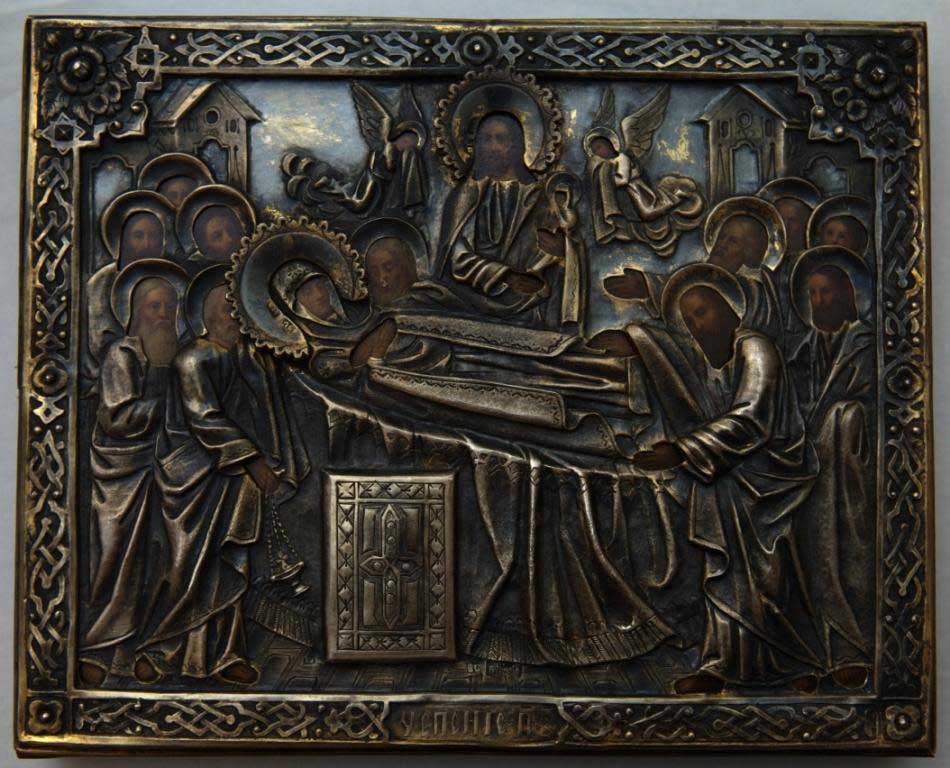  #Exhibit of the Month #Exhibit of the Month
August 2021
Icon of the Dormition of the Blessed Virgin
Russia, 1885, engraver V. Savinkov, tempera on wood
 The Dormition of the Most Holy Theotokos is considered a Great Christian Feast, when the Mother of God, upon her earthly demise, entered into heavenly glory. This feast, constituted with the evolution of the cult of the Virgin, is one of the earliest. The feast originated in Jerusalem, probably in the 4th century, and spread to the West in the 5th-6th centuries. The establishment of this feast strengthened the veneration of the Mother of God, as well as her Dormition, condemning some of the excesses of the cult of the Virgin, especially those associated with the delusions of the Collyridian heretics, who denied the human nature of the Most Holy Theotokos, including her worldly death. Originally celebrated on January 18, the Feast of the Dormition of the Most Holy Theotokos from 582 began to be marked on August 15 and was considered "the Easter of the Summer". Emperor Flavius Mauricius (c. 539-602) established that the day of August 15 be celebrated everywhere. The Dormition of the Most Holy Theotokos is considered a Great Christian Feast, when the Mother of God, upon her earthly demise, entered into heavenly glory. This feast, constituted with the evolution of the cult of the Virgin, is one of the earliest. The feast originated in Jerusalem, probably in the 4th century, and spread to the West in the 5th-6th centuries. The establishment of this feast strengthened the veneration of the Mother of God, as well as her Dormition, condemning some of the excesses of the cult of the Virgin, especially those associated with the delusions of the Collyridian heretics, who denied the human nature of the Most Holy Theotokos, including her worldly death. Originally celebrated on January 18, the Feast of the Dormition of the Most Holy Theotokos from 582 began to be marked on August 15 and was considered "the Easter of the Summer". Emperor Flavius Mauricius (c. 539-602) established that the day of August 15 be celebrated everywhere. The Holy Gospel is silent about this event, information about the circumstances of the Dormition of the Theotokos and the feast of the Virgin being preserved by popular tradition or related in the apocryphal writings. These sources, which convey the central moments of the event, also mentioned various details, suggesting different interpretations, the iconographic schemes evolving from one period to another. The initial compositions dedicated to the Dormition of the Blessed Virgin were laconic, with a small number of characters, but from the 10th-11th centuries, complex scenes with multiple characters appeared. The iconographic schemes were lined up both horizontally and vertically; in the first, the characters were located either to the left and right of the bier of the Virgin, or in a semicircle, in the second, the characters were depicted in large numbers behind the bier of the Virgin or (and) surrounding Jesus Christ, and the upper part of the icon was loaded with many images and details. Traditionally, the Blessed Virgin was depicted lying on a bier in the middle of a house, with her arms folded to her chest. On either side of her bed are candlesticks with lighted candles. At her feet the Apostle Peter is depicted with a censer, and at her head are the Apostles Paul and John the Theologian, who kisses her. Other apostles gathered around her, except for the Apostle Thomas, who was late. Above, to the left of the bed, Christ is shown in white robes, with a halo, in a shining mandorla or a clypeus, holding a swaddled baby in his arms, symbolizing the soul of the Mother of God. The theological meaning of this iconographic subject reflects the relationship between death and life, between the limited and the infinite, between the end and the beginning. In the schemes of the icons, these hypostases are symbolized by a horizontal line and a vertical line, personified by the lying body of the Virgin and by the image of the Savior with the baby in His arms. The iconographic model of the icon presented here resembles the famous icon from the Dormition Church in the Kiev Monastery of the Caves, brought there in 1073, probably from the Church of the Virgin of Blachernae in Constantinople. It is known that on these models, which probably reproduced the composition of the original icon, a silver door was installed or depicted on the left of the bed, which, decorated with a cross in the center, could be confused with a closed Gospel. At the same time, this decorative element on later copies could suggest that the specimen brought to Kiev in the 11th century belonged to the so-called reliquary icons, in which special recesses with silver doors were made for fragments of the relics of saints or their garments.
|



















































